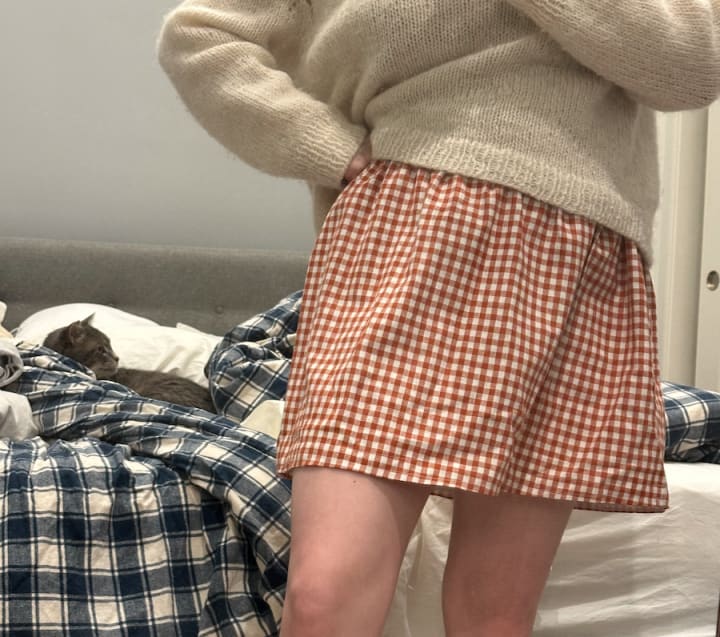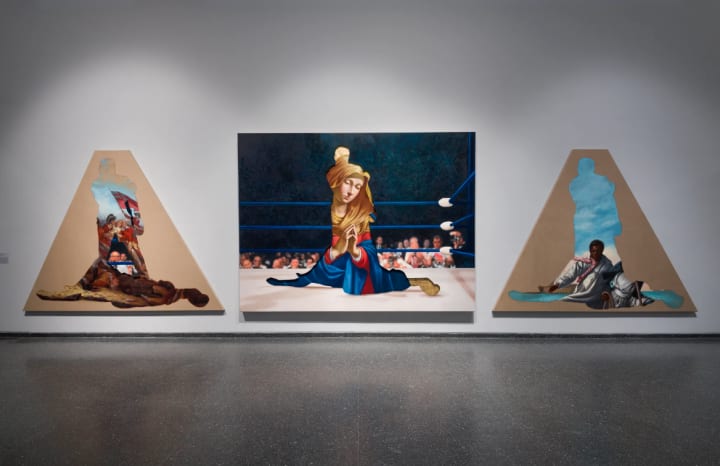Suze is Hunting Muses, 5
Back to our regularly-scheduled programming

Hi. My name is Suze Kay, and I’m a proud moderator of Voices in Minor, a community of Vocal authors who desire to uplift, inspire, and support one another. Every Wednesday, PViM will publish a weekly round-up of whatever lures my muses closer to my writing nook.
_________________________
No sooner had I welcomed Spring in my last installment than it turned tail, plunging New Jersey back into freezing temperatures. In the week since I last wrote, I've battled wind, rain, and a major case of the sniffles. But I also got to see and do some wonderful things, and I'm happy to share them with you below. This week, I...
Made a skirt.

Mondays are my day off from the restaurant where I work. Often, that doesn't mean I really get a day off -- there's always something to prep or test -- but at least I don't have any dinner customers to worry about. Luckily, one of my good friends has a flexible schedule and trendy taste, and she saved me from a good day wasted in my kitchen. She invited me to join her for a beginning sewing workshop at Brooklyn Craft Company, a craft store in Greenpoint where I've previously shopped for yarn.
Sewing machines scare me. I've heard horror stories of needles going through fingers, and also they're so... precise, and technical. They're fiddly. This class did nothing to disabuse me of these notions. The pedal was frighteningly responsive, and the in-and-out-and-up-and-down setup of the thread and bobbin almost did me in before I even turned the machine on. But once I got going, I thoroughly enjoyed myself.
It was all wonderfully tactile. The room smelled of hot cotton and old markers. I found the hiss of irons, the snick of fabric shears, and the hum of Singer sewing machines very soothing. The rhythm of creation enveloped me. It wasn't like writing, where I feel I have to pull something out of myself, bending words and scraping sentences together. It was more like cooking, where there's a recipe (the pattern), tools (rulers, scissors, machine), and ingredients (two yards of cotton and some thread), and then I solve the puzzle of putting it all together. Three hours passed in a blink, and now I have a lovely new plaid skirt to add to my summer wardrobe. I didn't get a story out of the experience, but maybe a poem. We'll see.
I also...
Saw a play.

I have a long personal history with John Patrick Shanley's stupendous play "Doubt: A Parable." In 2012, I analyzed the script (and the movie version starring Philip Seymour-Hoffman, Meryl Streep, and Amy Adams, which is well-worth a watch) for an independent playwriting study and came away convinced of its brilliance. In 2013, I performed a scene as the stern Sister Aloysius for a showcase at my high school. In 2014, I was cast as Sister James for a production at Yale. Each repeated instance of exposure only served to underline my initial impressions: Shanley is a master playwright, and this play deserved the Pulitzer Prize (and Tony Award!) it won.
The play's principal conflict is between the genial Father Flynn and Sister Aloysius, who suspects him of improper behavior towards a student attending their parochial school. Between them rockets the young and impressionable Sister James, who wants to impress each of them and believe the best of everyone. What I like best about the play, in every iteration that I've read, seen, or participated in, is that Shanley never answers the singular question which rules the audience's interest.
The first time I read the play, I knew (without a doubt): Yes, Father Flynn did it. The second time, I knew (without a doubt): No, he was wrongly accused. Rinse, repeat. At first, I found this constant reversal very frustrating. I just want to know what happened! I grew to love the beauty of this vagueness: how amazing that Shanley can write something so gripping, in which there are no easy answers. In which each viewer is free to make their own gut choices. In which they may have to analyze those choices critically, and wonder what it says about themselves, too.
Last Thursday, I was very lucky to be invited by a friend to see a revival performed on Broadway. What a show! Liev Schreiber, Amy Ryan, and Zoe Kazan are incredible in their roles. The set is magnificent, with moving rooms and a sky that almost seems real. The cast dug a wry humor out of the script that, for all my exposure, I hadn't seen before. And this time around, rather than continuing on my decade-long path of mulling over the duality of guilt or innocence, I focused on the hesitations. The doubts.
There's an exchange that's stuck with me.
Sister James: Did you make up that story about the pillow?
Flynn: Yes. You make up little stories to illustrate. In the tradition of the parable.
Sister James: Aren't the things that actually happen in life more worthy of interpretation than a made-up story?
Flynn: No. What actually happens in life is beyond interpretation. The truth makes for a bad sermon. It tends to be confusing and has no clear conclusion.
This gave me much food for thought. I'm always wondering about what makes a story good, what "meaning" means, and where the line between truth and fiction lies. It also gave me a new consideration for the play's subtitle, "A Parable." In this parable, there is still no clear conclusion. Except, I suppose, for the conclusion that doubt itself, to quote Father Flynn's opening monologue, "can be a bond as powerful and sustaining as certainty."
And with those thoughts swimming in my head, I finally...
Went to the museum.

For our six-month anniversary, my husband took me to see an exhibit at the Brooklyn Museum: 'Giants,' featuring highlights from the collection of Swizz Beatz and Alicia Keys. It's a monumental feat, one that exemplifies both their commitment to the Black diaspora and their exquisite taste. There are a great many pieces there worth seeing -- photographs by Gordon Parks, portraits by Kehinde Wiley, and a collection of small picture-window Jamaican landscapes by Barkley L. Hendricks stand out in my mind -- but my favorite was 'A Puzzled Revolution' by Titus Kaphar.
My first exposure to Kaphar's work came through 'The Jerome Project,' in which he painted devotional portraits of nearly a hundred imprisoned men who shared his father's name. Each portrait was painted over a golden background, underlining the series' Byzantine iconographic and stylistic themes, and coated in tar that partially obstructs the men's faces and identities. Kaphar processes many sociopolitical and racial themes through the iterative series: the mass incarceration of black men, the erasure of their identities, and the resulting cultural loss. It's a profoundly moving project.
In 'A Puzzled Revolution,' Kaphar continues his focus on the erasure of the black man through history. Above, you will see three canvases. Well, really four, but at any given time, three are visible. The central square canvas is the main one, featuring a painting of the boxing ring where Mohammed Ali stands over Sonny Liston (after Neil Leifer's famous photograph). But Ali and Liston are missing. They're cut from the canvas, leaving a hole, and instead, Kaphar offers three triangular options to replace them: a Renaissance-style Mother Mary, the climatic focal point of Benjamin West's "The Death of General Wolfe," and a close-up of the sole black sailor (unnamed, lost to history) of John Singleton Copley's "Watson and the Shark." Each can be fit behind the canvas, each offering the viewer a different question: What is victory? What is mercy? What is identity?
But each of those questions pales in comparison to the work's overall drive, and I'd venture to say that of the artist's entire oeuvre: What is the role of a black man in history? Out of love for my antsy husband, I didn't force him to wait through my chosen practice of art-worship (an uninterrupted half-hour of viewing a single painting, notebook in hand, scribbling every thought it brings to mind). But still, this painting is calling to me, and I think I need another visit. With my notebook.
_________________________
Thanks again for stopping by, dear reader. If any of you are within spitting distance of NYC, I highly recommend you also do everything I highlighted this week. I hope to catch you here again next week, when I'll have some new wonders and mysteries for you to ponder with me.
About the Creator
Proud ViM Productions
Alone, we are letters floating in the wind. Combined, we are an Opus. We hold community in our core, "We all rise when we lift each other up"






Comments (3)
Sounds like a pretty awesome week! Congrats on the annuversary! Flynn: No. What actually happens in life is beyond interpretation. The truth makes for a bad sermon. It tends to be confusing and has no clear conclusion.
This was quite interesting. So cooking, sewing, acting, art, writing. You have such diverse and, dare I say, artistic interests. That painting is fascinating. Great writing. Well done.
Next time I'm in New York, I want to go everywhere you wrote so enchanting about. Loved this! ❤️💜💕💜🌿